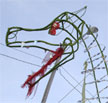Dragon's rage as he approaches water reflects both impotence and defiance. Aldrick Prospect, the protagonist of Earl Lovelace's Dragon Can't Dance, plays Dragon as an act of anonymous and directionless rebellion, a channel for expressing resentment at his own hopeless immobility. The St. Ann's River, dividing the slums of Laventille from downtown Port-of-Spain, creates both a physical and symbolic barrier that consigns those on both sides to their entrenched positions. Only in the altered space of Carnival, through the provisional freedom offered by the Mas, can such barriers be recognized and penetrated.
But, as with all archetypes of the Mas, the Dragon is a multilayered symbol, conflating contemporary social ills with historic legacies. Lovelace ties the Dragon's mythic act of crossing the water to Prospect's vestigial memory of the Middle Passage:
"with... a memory that had endured the three hundred odd years to Calvary Hill [Prospect] felt, as he put on his Dragon costume, a sense of entering a sacred mask that invested him with an ancestral authority to uphold the people of this Hill, this tribe marooned so far from the homeland that never was their home, the warriorhood that had not died in them, their humanness that was determined not by their possession of things. He had a desire, a mission, to let them see their beauty, to uphold the unending rebellion they waged, huddled here on this stone and dirt hill hanging over the city like the open claws on a dragon's hand, threatening destruction if they were not recognized as human beings." (112-113)
Click on any image to enlarge:
NOTE: Except where otherwise credited, all of the above photographs © 2006 Stefan Falke.
Usable only with permission of the artist. www.stefanfalke.com

 Back to Rights of Passage home
Back to Rights of Passage home